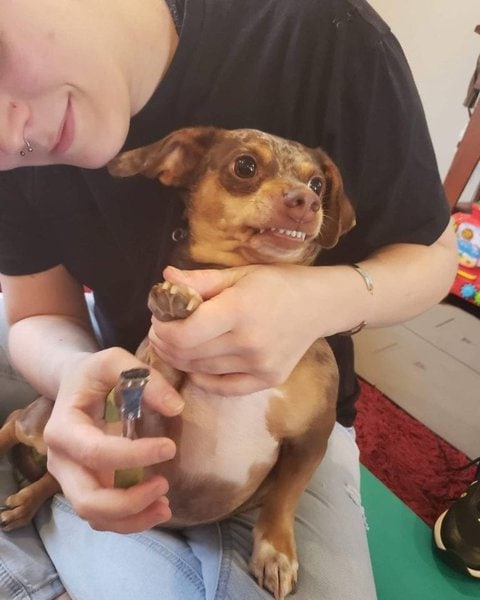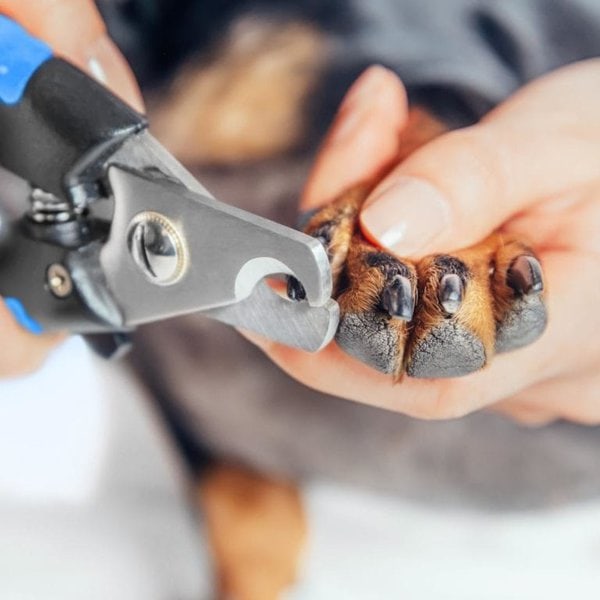Most dog owners know the importance of brushing and bathing their canine buddies, and even brushing their teeth, but nail trimming is an often forgotten grooming procedure. Actually, some dog owners don’t think trimming their dogs’ nails is necessary at all. So, what is the importance of nail trimming in dogs, and how often should you trim your dog’s nails?
Trimming your dog’s nails helps protect your four-legged buddy from health issues and injuries that could be brought about by overly long nails. In addition, trimming your dog’s nails also protects you from being accidentally scratched and injured by your pooch.
Your dog’s nails should be trimmed regularly to avoid overgrowing. If possible, this should be done about once every month.
If you are a dog owner and have been wondering whether it is worth the hustle of clipping your dog’s nails, we’ve written this guide purposely for you.
In this guide, we are going to cover everything you need to know about trimming your canine’s nails, including whether it is really necessary for your dog’s nails to be trimmed, as well as how to trim severely overgrown dog nails.
To start off, let’s take a look at one of the most critical concerns when it comes to trimming your dog’s nails – how to know when your dog’s nails need trimming.
How Do I Know When To Trim My Dog’s Nails?
You should trim your dog’s nails whenever they become too long. So, how long is too long for dog nails? You’ll know your dog’s nails are too long when they start touching the ground. You can tell your dog’s nails are touching the ground if they’re clicking while your dog is walking on hard surfaces, or getting caught by your carpet.
While it is advisable to trim your doggo’s nails every couple of weeks, or every month at the very least, it is good to note that there’s no standard nail trimming frequency that works for every dog. Some will require more frequent trimming than others.
The factors that affect how often you need to trim your dog’s nails include:
Surface Type
The kind of surface your dog spends time on has an effect on how fast your dog’s nails grow. If your dog spends a lot of time outdoors on dirt and on surfaces like pavement or concrete, these surfaces will wear out their nails, so they won’t need to have their nails trimmed very often.
However, if your canine buddy spends most of their time indoors, and only walks on grass lawns when you allow them outside, there’s nothing to wear out their nails, so they’ll need more frequent trimming.
Age
Older dogs are less active. They spend less time running outside and engaging in other activities that could wear out their nails, such as digging. As a result, their nails grow much faster and require more frequent trimming.
Diet
Your fido’s diet also has an effect on how fast their nails grow. If your doggo’s diet is rich in minerals and vitamins, this will spur your dog’s nails to grow faster, and therefore, you’ll need to clip their nails more often.
Breed
The breed has an impact on how fast your dog’s nails grow. Breeds that were specifically bred to hunt burrowing animals, such as Terriers, Dachshunds, and Miniature Schnauzers tend to have nails that grow fast, and therefore, such breeds require their nails to be clipped frequently.

Do Dogs Really Need Their Nails Trimmed?
Yes, dogs need to have their nails trimmed whenever they grow too long. Failure to trim overgrown nails can hurt dogs and cause various health problems for your pooch, and at the same time increase their risk of injury.
Here is what happens if you don’t cut your dog’s nails.
Posture Problems And Limping
If your dog’s nails are overgrown and touching the ground, this means that they’ll push back on the nail bed every time your dog is walking. This can be painful for your pooch, and to ease the pain, your dog will change their posture, which will, in turn, create undue pressure on your dog’s toe joints.
Over the long term, this can affect your dog’s posture and lead to problems like limping, even after you cut off the nails. In extreme cases, poor posture can even lead to problems like back pain, arthritis, and even hip dysplasia. To prevent this, don’t allow your doggie’s nails to grow too long.
Ingrown Nails
A dog’s nails usually curl downwards. If they are left to grow too long, they could continue curling and turn inwards, towards the paw pads. This is particularly common in small-sized breeds, such as Chihuahuas and Pugs.
If the nails start growing into the paw pads, this can be very painful for your pooch. This pain can make walking and running very difficult for your dog. In addition, such ingrown nails minimize your dog’s traction, increasing their likelihood of getting injuries from slips and falls.
Toenail Injuries
The longer your dog’s nails grow, the more likely they are to be caught in things such as roots, cracks on the pavement, and rocks. When this happens, the nails could break or even get torn off completely, causing very painful injuries that could also be susceptible to infections.
Splayed Feet
Sometimes, instead of curving inwards towards the paw pad, an overgrown nail will splay to the side and continue growing.
With time, this forces your dog’s toes to tilt in the same direction as the nail, effectively splaying your dog’s toes, deforming your dog’s feet, and injuring the toe and feet tendons. Eventually, this can make it very difficult for your canine buddy to walk or run properly.
Explained as above, all these potential problems illustrate the importance of nail trimming in dogs.

How Do You Trim Severely Overgrown Dog Nails?
To trim severely overgrown dog nails, ensure that your pooch is comfortable, ensure that you have the right tools, and then start trimming, making sure not to cut the “quick.”
Let’s look at this process in greater detail.
Ensure Your Dog Is Comfortable
Some dogs don’t like having their paws touched. Therefore, before you start trimming your doggo’s nails, you should ensure they’re comfortable with you handling their paws.
To get your dog comfortable, start by simply holding its paws for a few moments to get them used to this new sensation before you move on to the actual trimming.
Get The Right Tools
To cut your dog’s nails properly, you need a nail clipper that is designed specifically for dogs. This will make the task easier and minimize the risk of injury for your dog.
A good option is the BOSHEL Dog Nail Clippers And Trimmer, which is ergonomically designed and is fitted with a safety sensor that ensures you don’t cut your dog’s nails too short and cause injury to your fido.
Find The Quick
Dog nails have a collection of blood vessels and nerves, known as the “quick”, running at their center. Cutting through the quick can cause pain and bleeding.
To avoid this, locate the quick before you start trimming. If your dog has light-colored nails, you’ll see the quick as a section of the nail that appears dark and pinkish. For dogs with dark nails, however, finding the quick can be difficult.
Start Trimming
Once you locate the quick, you can now start trimming your dog’s nails, taking care to cut the nail a few millimeters from the tip of the quick.
For dogs with dark-colored nails, cut the nails a small bit at a time and observe to see if you notice any pinkish part on the cut section. Keep doing this until you notice this part, which signifies that you are close to the quick. Once you see this pinkish part, don’t trim the nails any further.
For dogs with very long nails, trim a small bit off the nail, wait about a week for the quick to recede, then cut another small bit and wait another week for the quick to recede even further. Keep doing this until you get the nails to the desired length.
How Often Can I Trim My Dog’s Overgrown Nails?
You should trim your dog’s overgrown nails as frequently as required to keep them within the desired length. Ideally, at least once every month should be enough to ensure the nails don’t grow too long.






